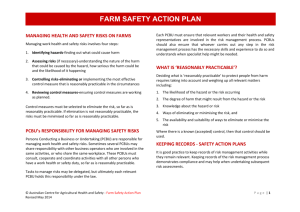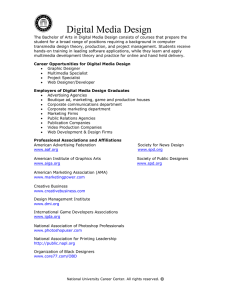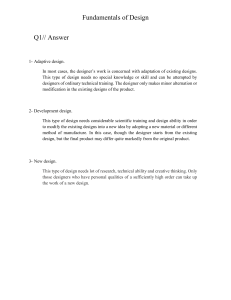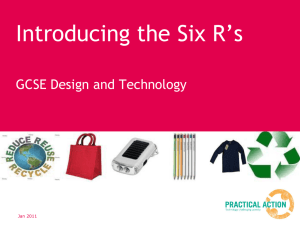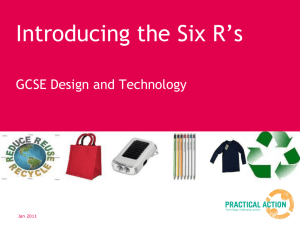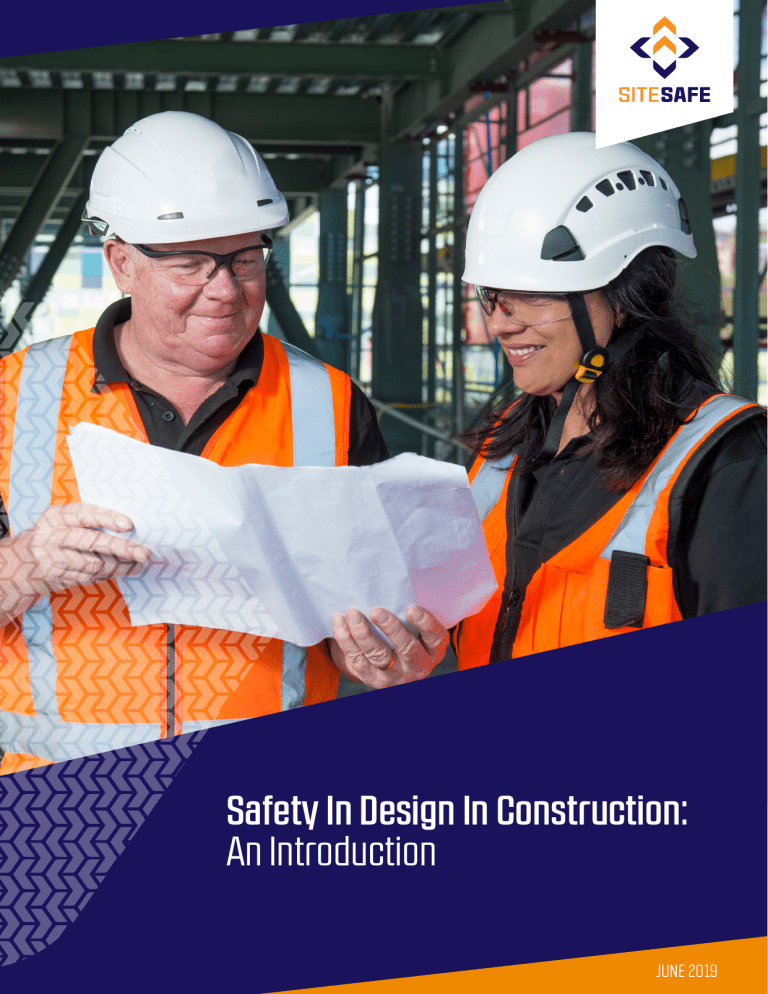
Safety In Design In Construction: An Introduction 1 JUNE 2019 CONTENTS Introduction 3 Who is a designer? 3 Safety in design 4 The design project lifecycle 4 Benefits of safety in design 5 Person conducting a business or undertaking (PCBU) 6 Responsibilities of upstream PCBUs 7 The three Cs 8 Steps to ensuring health and safety in design 9 Step 1: Engage with your client 10 Step 2: Research and brainstorm 11 Step 3: Understand the health and safety risks 12 Step 4: Sense check/test for safety 18 Step 5: Provide information 18 Step 6: Review 20 Your checklist 20 How Site Safe can help 20 Other resources 20 2 INTRODUCTION This guide is designed to help you as a designer of structures, and those that work with you, understand the basics of safety in design, so your work will not put anyone’s health and safety at risk. As a person conducting a business or undertaking (PCBU) in design, it is good business practice, and a legal requirement, for you to create designs that will reduce risk to the safety of clients, builders, users, those who service and maintain the structure, and any other people who could be affected by your work. The best and most cost-effective way to do this is to plan for health and safety right from the start, when design decisions can most proactively influence the way buildings and structures are constructed, used and maintained – Safety in Design. Safety in design is about changing the health and safety outcomes throughout the lifecycle of a project or asset. This is achieved by embedding safety concepts at the earliest stages of project development. In developing this approach and implementing it efficiently, the costs of every stage of a project, as well as its long-term costs, tend to be reduced. A safe design requires a good understanding of human behaviour - it’s not just about reducing injuries and deaths; it also leads to better staff morale for those who will work on and with your designs, higher productivity and reduced ongoing costs for you and your client. Other PCBUs, such as clients and contractors, will also find this guide useful in helping to ensure the designers they have engaged are meeting their duties and delivering a quality project. The Health and Safety at Work Act requirement is the designer must, so far as is practicable, ensure that the plant, substance or structure is designed to be without risks to the health and safety of persons. WHO IS A DESIGNER? Designers include those who direct, constrain, undertake or alter designs. The following groups can have responsibilities as a designer to a greater or lesser extent depending on their involvement: ›› Architects, engineers, interior designers, landscape architects, town planners, building service designers, temporary works engineers, planners, architectural designers. ›› Owners, clients and project managers because they direct or constrain designs and are responsible for employing suitably qualified persons to undertake the design. ›› Contractors undertaking works when they alter or change a design or materials in such a way that it changes the safety outcomes for an asset. 3 SAFETY IN DESIGN As “upstream PCBUs”, designers are in a prime position to influence the health and safety aspects of the products and structures they design before they are built and used in work situations. As the lifecycle of a design project progresses, the ability to influence the design for health and safety decreases and the cost of incorporating health and safety strategies increases, as shown in Figure 1. Demolition Construction Detail of Design Preliminary Design Concept Operation & Maintenance Cost to manage health and safety risks Ability to influence safety of the design Under the Health and Safety at Work Act 2015, the end users – the workers who will work in or with a building or structure you design, and/or anyone who will be affected by it — have the right to the best level of health and safety protection that is reasonably practicable. Foreseeing and managing potential health and safety risks early in the design stage is far cheaper and much more effective than mitigating risks during construction, or retrofitting for health and safety later in the lifecycle of a design project. Figure 1: Symberszki chart of influence over a product’s life cycle (adapted from Symberszki, R, (1997), Construction Project Safety Planning. TAPPI Journal, 80 (11), 69–74) THE DESIGN PROJECT LIFECYCLE A design project should assess and incorporate considerations of every lifecycle stage of a structure – from conception and design through to construction, use for purpose, maintenance and repair, decommissioning or repurposing, and eventually to demolition. Conception Design Construction Use for purpose, maintenance & repair Decommission/ Repurposing Demolition 4 BENEFITS OF SAFETY IN DESIGN There are many benefits from safety in design, some of which include: ✓✓ Significant reductions in work-related ill health and injuries – particularly during the construction and maintenance stages of a project lifecycle ✓✓ Improvement in the health and wellbeing of workers ✓✓ Reductions in damage to property and the environment – with associated reductions in related costs Safety in design is NOT about: ›› Stifling the creativity of designers; rather it encourages imagination and innovation ›› Requiring designers to specify standard construction processes ›› Requiring designers to take into account unforeseeable hazards ›› Requiring designers to spend meaningless time on paperwork; efficient and transparent procedures will minimise effort and paperwork ›› Developing site safety plans which address typical construction risks. This is expected to be the responsibility of the contractor once appointed. ✓✓ Elimination of potential hazards at the beginning of the project – which is often cheaper and easier than minimising their effects later in the lifecycle ✓✓ More efficient and effective risk management at the design stage rather than retrofitting for health and safety during the use and maintenance stages ✓✓ Reductions in operational maintenance and litigation costs when things go wrong With these benefits in mind, good designers seek to incorporate safety by design concepts and details into every aspect of their designs and for every stage of the project lifecycle. Design for safe construction Design for safe demolition Design considerations Design for safe modification Design for safe use Design for safe inspection Design for safe maintenance and repair 5 PERSON CONDUCTING A BUSINESS OR UNDERTAKING (PCBU) PCBU Duties - Primary Duty of Care All PCBUs must ensure, so far as is reasonably practicable, the health and safety of people is not put at risk by the work it undertakes. This is the PCBU’s primary duty of care. Examples of who might be affected by a PCBU’s activities are shown in the following figure. Members of the public Visitors to the workplace PEOPLE WHO MAY BE AFFECTED BY A PCBU’S WORK People who work for the PCBU – includes contractors, subcontractors and their workers People whose work activities are influenced or directed by the PCBU, such as contractors or other workers at a shared workplace Duties of PCBUs All PCBUs have a range of duties that they must, so far as is reasonably practicable, meet as shown in the following figure. REASONABLY PRACTICABLE DUTIES OF PCBUS Provide and maintain a work environment that is without risk to health and safety Provide and maintain safe plant, structures and systems of work Ensure safe use, handling and storage of plant, substances and structures used for work Provide information, training instruction and/or supervision to protect all persons from risk to health and safety Monitor the health and safety of workers and conditions at the workplace for the purpose of preventing injury and illness. Engage workers and/or their representatives about decisions on health and safety in the workplace Provide adequate facilities for the welfare of the workers at work. 6 RESPONSIBILITIES OF UPSTREAM PCBUS Designers may also be what is known as ‘upstream PCBUs’. These designers have specific duties as PCBUs as shown in the following figure. Designers who: Duties of designers as upstream PCBUs – so far is reasonably practicable: ›› design structures or other works where people will, or may occasionally, work or require access for operation and maintenance ›› ensure that structures, plant and substances are without health and safety risk ›› carry out tests to ensure the structure, plant or substance they have designed is without risk design things for use at a workplace, or ›› provide all relevant information about their designs ›› consult, cooperate and coordinate with other PCBUs install, build or commission plant, or structures that will be used as a workplace ›› ensure their designs comply with all relevant legislation ›› ›› 7 THE THREE CS Overarching principles as you work to achieve safety in design are for you to consult, coordinate and cooperate with your client and other PCBUs involved in the design of the project. A designer may not have management responsibilities for, or control of, the construction work, but the designer still has duty as a PCBU to consult, co-operate and co-ordinate, so far as is reasonably practicable, with the other PCBUs involved in the project. More than one PCBU typically has duties around the specific or general matters of a design. In practical terms, this means designers should provide information on how health and safety considerations have been incorporated into a design, which risks have been identified through the design process, how they have been eliminated or otherwise mitigated, and list any residual risks. In complex projects, there may be several PCBUs, each with overlapping duties and obligations towards the design. The lead consultant is likely to have more ability to influence or control the direction and outcomes of a design. In this case, a designer should seek to agree and clearly document the extent of its influence or control and responsibilities towards the design development. Each practice involved in the design will owe a duty as a designer. Where proprietary parts of projects such as roof trusses, glazing, air-conditioning and curtain walling are designed by contractors and/or sub-contractors, or the design changed in the course of construction, the PCBU that has designed each independent part will owe a duty as a designer. In addition, anyone undertaking, constraining, directing, or altering a design must consult all others who are currently or have been involved in the development of the design. This includes changes to design arrangements or materials that often occur during construction. It is also worth noting that there is an implied requirement in the legislation for the client/owner to select suitably qualified persons to undertake the design and construction. PCBUs Client Designer Principal Contractor Sub - Contractor Consult, Coordinate, Cooperate Consultation 8 STEPS TO ENSURING SAFETY IN DESIGN 1. 3. 5. Engage with your client to help you understand the health and safety risks of the project 2. Research and brainstorm to find the best options for each stage of the project’s lifecycle – consider both the introduced factors (if any) from the client, as well as your design response to the brief 4. Sense check/test your design ideas for safety and adapt your design to reduce the risk of harm to contractors and the users of the completed building or structure. Follow approved codes, standards/regulations 6. Review your design for health and safety learnings at the end of the project which could be applied in future work Scope, assess and understand the health and safety risks throughout the lifecycle of your design project Document and provide information to your client and any other PCBUs involved in the project on the mitigating measures which have been introduced as well as any residual risks that remain 9 STEP 1 - ENGAGE WITH YOUR CLIENT The first step towards delivering a healthy and safe design is to understand the project. You need to engage with your client to develop your understanding of what they need and want from your design. 1. Make sure you get a thorough brief from your client covering such things as: 4. What hazards may be involved in those processes, for example: ›› use of hazardous substances ›› access and egress for people and products 5. Are there process-specific and/or site-specific potential safety hazards, for example: ›› what the building or structure will be used for ›› who will use it ›› restricted access ›› where it will be sited ›› uneven topography ›› what are the possible extreme conditions it will be required to accommodate ›› poor drainage ›› wind exposure ›› seismic hazards ›› emergency access for appropriate services ›› proximity to high-risk features e.g. water bodies, traffic networks 2. This will enable you to begin to identify potential health and safety risks, such as: ›› What sort of activity or processes will be undertaken in or around the structure throughout its lifecycle, for example: ›› noisy work that needs to be dampened ›› work at heights that may be able to be designed out ›› detail work that has particular lighting requirements ›› use of heavy machinery that will require special structural support Remember – planning for health and safety at the very earliest stages of project development results in reduced costs for your client down the track. 3. How will designing for those processes affect how the structure is constructed, for example: ›› incorporating soundproofing materials and/or design features ›› incorporating use and maintenance features that design out or reduce the need to work at height ›› avoiding confined spaces for operation and maintenance ›› including sufficient width in access corridors for people with appropriate tools ›› designing in suitable lighting ›› ensuring adequate building strength 10 STEP 2 - RESEARCH AND BRAINSTORM Research materials and features used in other structures used for similar purposes and in similar situations. Find out all you can about how health and safety has been planned for in those structures. Find out about any health and safety risks or issues with those structures. At each stage of the design lifecycle, meet with others involved in the project to brainstorm health and safety issues as the design development progresses. Early in the design set up a safety team which meets regularly that includes capable people with various skill and knowledge sets. On bigger projects, this may include a specific Safety in Design manager or leader. Depending on the size, type and stage of your project, this might include some or many of the following: ✓✓ The project client, land owner, building owner ✓✓ Designers, engineers, architects, technical experts ✓✓ Managers, workers, health and safety To function well, safety teams need: ✓✓ An effective facilitator with a broad knowledge of the subject matter ✓✓ Clear goals ✓✓ Strong leadership ✓✓ Good understanding of the project objectives including work processes ✓✓ Good understanding of human behaviour in normal and unfamiliar circumstances ✓✓ Technical knowledge of products, materials and construction techniques ✓✓ Regular meetings ✓✓ Clear recording and distribution of information Research ways the potential health and safety issues can be designed out or managed in your design. representatives ✓✓ Construction industry advisors: builders, electricians, plumbers ✓✓ Maintenance and repair industry workers, cleaners, service agents ✓✓ Supply chain stakeholders (upstream and downstream) ✓✓ Advisors from regulatory and advisory bodies such as local councils, Site Safe ✓✓ Iwi representatives and environmental advisors Different combinations of skill and knowledge sets may be necessary for different stages or to deal with different aspects of the design. Safety teams or safety workshops can be set up whenever necessary throughout the design development process. 11 STEP 3 - UNDERSTAND HEALTH AND SAFETY RISKS THROUGHOUT THE LIFECYCLE OF YOUR DESIGN Think about: Think about how each of these groups of people may be affected by each aspect of the structure, plant or product. ›› who will construct the structure or product ›› who will work in it, inspect it and/or maintain it ›› who might visit it, or live or work near it ›› who will be affected in extreme conditions ›› who will eventually demolish it Think about what aspects of the product or structure could pose health and safety risks in what circumstances and how. As far as is reasonably practicable, incorporate health and safety concepts and eliminate or minimise risks. Develop Concept Disposal/recycle Decommission Procurement Lifecycle Maintain Design Commission/use Construct/manufacture Install/supply 12 Risk Assessment and Hazard Management One aspect of the Safety in Design process is to incorporate within the design development process risk assessments and hazard management. The most effective means of controlling risk is to eliminate hazards; this approach is often cheaper and more practicable to achieve at the design or planning stage. Eliminating potential hazards at the beginning of the project is often cheaper and easier than minimising their effects later in the lifecycle. A risk assessment methodology should be appropriate to the project and the stage in its design development. There are several formal approaches to identifying hazards as a preliminary task in risk assessments. Common methodologies for hazard identification include: ›› Hazard and Operability studies (Hazop) ›› Event Tree Analysis (ETA) ›› Fault Tree Analysis (FTA) ›› Fault Mode Effects analysis (FMEA) ›› Preliminary Hazard Analysis (PHA) ›› Human Reliability Analysis (HRA) ›› Construction Hazard Assessment Implication Review (CHAIR) ›› Bow Tie Analysis An example Bow Tie Analysis is shown below: BOW TIE ANALYSIS Various distinct causes of the top event The activity or equipment with the potential to cause harm Realistic worst-case outcomes of the top event Threat Hazard Consequence Controls Risk Threat Controls Threat Controls The scenario which represents losing control of the hazard Response/ control Consequence Response/ control Consequence Response/ control Measures to prevent or mitigate a threat Prevention Mitigation 13 Steps to Assess Risk 1. Identify the hazard 2. Assess — what the level of risk is for each hazard identified: Identify potential health and safety hazards at each stage of the lifecycle including risks from extreme conditions such as: wind, flood, fire and earthquakes and normal operating conditions such as: ›› how severe could the potential harm be (for example minor or short-term injury, permanent injury or illness, death)? ›› confined spaces ›› ›› energy sources how likely is each potential hazard to actually cause harm? ›› hazardous substances ›› working at or maintaining structures at height ›› hazardous work processes ›› injury by plant or equipment ›› risks to the environment ›› end of life conditions such as: ›› ›› ›› Use a risk matrix to help with the risk assessment. demolition rapid collapse and material disposal RISK ASSESSMENT MATRIX 14 3. Control So far as is reasonably practicable, develop designs that are inherently safe and eliminate hazards. Where hazards cannot be eliminated, design to minimise their effects using the hierarchy of controls. Use a hierarchy of control chart to help identify the level of control required for each hazard identified. The better the level of control, the lower the residual level of risk. The best control is to use safety in design to eliminate hazards from the project right from the start. HIERARCHY OF CONTROLS 4. Reassess 5. Review Go back and reassess the impact of the proposed controls on the identified risks. Adjust or add controls, so far as is reasonably practicable to further eliminate or minimise residual risks. Record any remaining risks which need to be managed by other PCBUs. When the design has been accepted and constructed, review all aspects of the design to gain insight for use in future design projects. Where possible, a designer should continue to review the project throughout its lifecycle to learn as much as possible for application to other projects and research. As part of the safety in design process, this reassessment should continue throughout design development for the project, and should address new hazards as they arise through changes to the design, through work processes, or undertaking construction work using the design. Where appropriate, inspections and audits, workplace health and safety meetings, client and worker feedback, regulatory health surveillance, and environmental monitoring can all provide useful additional information for risk assessments of certain designs or specific projects. 15 Examples of Controls Elimination Develop structural arrangements that are inherently safe, for example; eliminate confined spaces, minimise heavy components hanging from ceilings such as heavy HVAC systems, site structures above flood levels, provide adequate safe access to roofs and exterior surfaces for maintenance, provide adequate head room for safe passage. Design components that facilitate pre-fabrication on the ground to avoid working at height during construction thereby eliminating the risk of falls. Substitution Replace a hazardous process or material with one that is less hazardous to reduce the risk. For example: use pre-cast panels rather than constructing a masonry wall, use pre-finished materials in preference to on-site finishing, avoid combustible materials. Isolation Separate the hazard or hazardous work practice from people, for example designing the layout of a building so that fires cannot spread across zone boundaries, hazardous materials are separated and contained, were possible provide adequate passive venting and adequate natural lighting, and ensure noisy machinery is isolated from workstations. Engineering controls Use engineering control measures to minimise the risk, for example; include adequate ventilation and lighting in the design, designing and positioning permanent anchorage and hoisting points into buildings for cleaning (windows) and maintenance work to be undertaken at height. Administrative controls If engineering controls cannot reduce the risk sufficiently, then administrative controls should be used, for example using warning signs or exclusion zones where a hazardous activity is carried out. Personal protective equipment (PPE) For example hard hats, respiratory protection, gloves, ear muffs etc. should be used to protect the worker from any residual risk. PPE is the least effective control measure because it relies on the worker’s behaviour and therefore requires thorough training and a high level of supervision to be effective. In many cases a combination of control measures will be required to minimise the risks to health and safety. For example, traffic flow at a workplace may be controlled by incorporating traffic islands (engineering) and erecting warning signs (administrative). 16 EXAMPLES OF SAFETY IN DESIGN Air conditioning units located at ground level, rather than at height. Design safe access methods to service areas such as roofs. Fold down lighting eliminates the risk of working at height. Windows that open inwards rather than outwards. 17 STEP 4 – SENSE CHECK/TEST FOR SAFETY As the designer, you have a duty to develop a design that incorporates safety principles. You must carry out calculations, analyses, tests or examinations needed to make sure the structure you design is, so far as is reasonably practicable, without health and safety risks. Follow approved codes, standards and regulations. Where multiple designers contribute to a project, they all hold responsibilities to carry out their duties for the individual parts they are designing. You must also consider how the components will interact with each other so that individually or when used in combination they should not present health and safety risks. STEP 5 - PROVIDE INFORMATION You have a duty to provide information about how your design has incorporated considerations of health and safety and any remaining risks to be managed by other PCBUs. You must provide this information to anyone who has been provided with the design, so they can make informed decisions about accepting your design and commissioning contractors to construct it. Any record of information should remain open at least until construction has been completed. Throughout your design projects, it is important that you document your reasoning, research, tests, analyses, consultation, agreements, risk assessments. Depending on the size of the project, this documentation may include, but not necessarily be limited to, notes about safety on your plans and/or including a safety checklist or health and safety comments box on an existing checklist or register. While the Act does not specify how safe design information should be communicated from designers to clients, contractors and users, depending on the size of the project, it may be useful to consider the following: ›› Safety notes on plans ›› Risk Register ›› Health and Safety section in specification notes ›› A Health and Safety File within the project file ›› Safe Design Report/Design Construction Safety Report or Statement ›› Post-construction Review Report Any design changes made during the construction stages of the project must be assessed against the original design documentation to ensure they do not introduce any new hazards or increase risk. Any proposed design changes, including changes to materials, requires communication with all those who have been involved in the design and should also trigger an update of the risk assessment for all affected aspects of the project. Any changes should be documented on as-built plans and in the risk register. Risk Register The risk register should include: ›› Your risk analysis and hazard management planning ›› Records from any safety team meetings or workshops The risk register should be updated throughout the lifecycle of your design with information about any changes that could affect health and safety aspects of your design. 18 Health and Safety File ›› The health and safety file could include information such as: Residual risks to be dealt with by contractor or client ›› Any construction work that takes place during the lifecycle of the structure ›› Any conditions necessary to ensure that the structure is without risks when used for the purpose for which it is designed or when carrying out any activity in relation to the structure such as construction, maintenance and demolition ›› Results of any testing and analysis ›› Any design changes to eliminate or minimise identified risks ›› The designer’s risk assessment and safe design report/the risk register ›› Correspondence between stakeholders ›› Details of any consultation or research that has been undertaken ›› Safety meeting/workshop notes ›› Safety data sheets ›› Manuals/information on how the structure can be safely maintained or demolished It could also include a health and safety checklist such as is shown in the Appendix of this guide. Safe Design Report For larger projects, the safe design report is begun early in the project and added to throughout. Any residual risks from the design stage should be highlighted. It should also outline any potential hazards that are unique to the particular design project. Each designer involved in the project (e.g. engineers, landscape designers, interior designers and plant designers) should provide information about how they have designed their component of the structure to be without risk. The report should cover all of the lifecycle stages so that relevant information is readily available to people further along the lifecycle of the structure. The safe design report can also help designers fulfill part of their duties to consult with other duty holders and transfer information to relevant people such as the client, other designers, the principal contractor, maintenance contractors and demolition contractors. The safe design report should include: ›› The purpose for which it was designed ›› The results of any testing or analysis ›› Actions you have taken to reduce the risk, e.g. design changes or changes to construction methods ›› Risk register and hazard controls 19 STEP 6 – REVIEW Once your design has been accepted and built, it is good practice to review the whole process to see what you can learn to take forward into future design projects. ›› What worked well? ›› Did anything present unexpected health and safety problems? ›› How were any unexpected health and safety issues dealt with? ›› How might they be avoided in future projects? On completion of construction, the effectiveness of safety in design should be evaluated. This will enable identification of the most effective design practices and any design innovations that could be used on other projects. For larger projects, the review may be carried out in a post-construction workshop attended by all relevant parties involved in the project. Subsequent feedback from users to assist designers in improving their future designs may be provided through: ✓✓ Keep records (e.g. risk register, health and safety file, testing and research information, minutes from safe design workshops) ✓✓ Review your design for future learnings ✓✓ Keep up-to-date with information that might affect safe design How Site Safe Can Help Site Safe offers a range of courses and support services including: ›› The New Health and Safety at Work Act Guide ›› Risk Management 101 Guide ›› The Managing Contractors Guide ›› SiteWise ›› Risk Management course ›› Post occupancy evaluations for buildings ›› Health and Safety in Contracting course ›› Defect reports ›› Foundation Passport – Consultants ›› Accident investigation reports ›› Consultancy ›› Information regarding modifications ›› Auditing ›› User difficulties ›› Deviations from intended conditions of use Your Checklist ✓✓ Engage with your client to get a thorough brief ✓✓ Consider all stages of the structure’s lifecycle during design ✓✓ Consult with all those affected by design ✓✓ Eliminate or control risks ✓✓ Communicate with relevant parties through all phases of project Other Resources ›› Health and Safety by Design: an Introduction (WorkSafe) ›› Model Code of Practice: Safe Design of Structures (Safework Australia) ›› Health and Safety at Work Act 2015 20 APPENDIX – EXAMPLE SAFETY IN DESIGN CHECKLIST (From the Safe Design of Structures, Model Code of Practice, July 2012, Safe Work Australia. You may wish to adapt this example list to better suit your project’s risks, and/or stage of design.) The following list may be used to assist in identifying hazards and controlling risks associated with the design of a structure throughout its lifecycle. Working environment ☐☐ Ventilation for thermal comfort and general air quality and specific ventilation requirements for the work to be performed on the premises ☐☐ Temperature ☐☐ Lighting including that of plant rooms ☐☐ Acoustic properties and noise control, for example, noise isolation, insulation and absorption Electrical safety ☐☐ Earthing of electrical installations ☐☐ Location of underground and overhead power cables ☐☐ Protection of leads/cables ☐☐ Number and location of power points Fire and emergencies ☐☐ Fire risks ☐☐ Fire detection and fire fighting ☐☐ Emergency routes and exits ☐☐ Access for and structural capacity to carry fire tenders ☐☐ Other emergency facilities Movement of people and materials ☐☐ Safe access and egress, including for people with disability ☐☐ ☐☐ ☐☐ ☐☐ ☐☐ Traffic management Loading bays and ramps Safe crossings Exclusion zones Site security ☐☐ Seating ☐☐ Floor surfaces to prevent slips and trips ☐☐ Space for occupants Plant ☐☐ Tower crane locations, loading and unloading ☐☐ Mobile crane loads on slabs ☐☐ Plant and machinery installed in a building or structure ☐☐ ☐☐ ☐☐ ☐☐ Materials handling plant and equipment Maintenance access to plant and equipment The guarding of plant and machinery Lift installations Amenities and facilities ☐☐ Access to various amenities and facilities such as storage, first aid rooms/sick rooms, rest rooms, meal and accommodation areas and drinking water Earthworks ☐☐ Excavations (for example, risks from earth collapsing or engulfment) ☐☐ Location of underground services 21 APPENDIX – EXAMPLE SAFETY IN DESIGN CHECKLIST (CONT.) Structural safety ☐☐ Erection of steelwork or concrete frameworks ☐☐ Load bearing requirements ☐☐ Stability and integrity of the structure ☐☐ Scaffolding ☐☐ Temporary work platforms ☐☐ Roofing materials and surface characteristics such Manual tasks ☐☐ Methods of material handling ☐☐ Accessibility of material handling ☐☐ Loading docks and storage facilities ☐☐ Workplace space and layout to prevent Specific risks ☐☐ Exposure to radiation, for example, musculoskeletal disorders, including facilitating use of mechanical aids ☐☐ Assembly and disassembly of pre-fabricated fixtures and fittings Substances ☐☐ Exposure to hazardous substances and materials including insulation and decorative materials ☐☐ Exposure to volatile organic compounds and off as fragility, slip resistance and pitch electromagnetic radiation ☐☐ ☐☐ ☐☐ ☐☐ ☐☐ ☐☐ Exposure to biological hazards Fatigue Working alone Use of explosives Confined spaces Over and under water work, including diving and work in caissons with compressed air supply Noise exposure ☐☐ Exposure to noise from plant or from surrounding area gassing through the use of composite wood products or paints ☐☐ Exposure to irritant dust and fumes ☐☐ Storage and use of hazardous chemicals, including cleaning products Falls prevention ☐☐ Guard rails ☐☐ Window heights and cleaning ☐☐ Anchorage points for building maintenance and cleaning ☐☐ Access to working spaces for construction, cleaning, maintenance and repairs 22 23 Site Safe New Zealand PO Box 9445 WELLINGTON P: 04 815 9180 F: 04 473 8541 E: comments@sitesafe.org.nz



